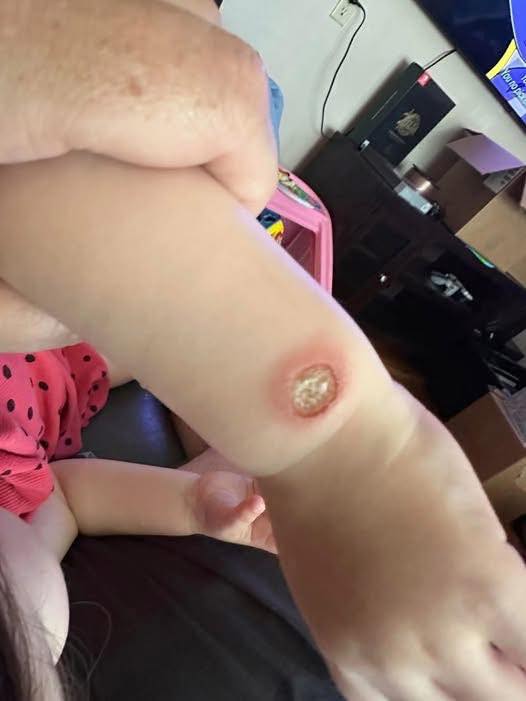A rare and unusual medical case has drawn attention in the field of respiratory and dermatological medicine after a 55-year-old woman developed Sweet syndrome following a routine change in her inhaler therapy. The woman, who had a history of chronic obstructive pulmonary disease (COPD) and hypertension, was switched from formoterol to indacaterol/glycopyrronium as part of her treatment plan. Within just 48 hours of starting the new inhaler, she experienced a sudden onset of intensely painful, bright red skin lesions across her face and neck, accompanied by a low-grade fever.
At first, the symptoms raised suspicion of a more common reaction such as dermatitis, urticaria, or even a simple cosmetic irritation. The patient herself reported no changes in her skincare products, dietary habits, or recent exposure to infections. Yet the severity and rapid progression of the symptoms prompted further investigation. Standard blood tests were performed to rule out autoimmune disease and infectious triggers, both of which came back negative. Given the unusual presentation, a skin biopsy was ordered.
The biopsy results provided a definitive answer: Sweet syndrome, also known as acute febrile neutrophilic dermatosis. This rare condition is characterized by the sudden eruption of painful, inflamed skin lesions, most often accompanied by fever, elevated white blood cell counts, and systemic symptoms. It is understood to be driven by abnormal immune responses, where neutrophils, a type of white blood cell, infiltrate the skin and trigger severe inflammation. While the syndrome has been documented in association with underlying malignancies, autoimmune conditions, infections, and certain medications, its emergence following the use of an inhaled therapy was previously undocumented.
Traditionally, medications such as antibiotics, antiepileptics, and vaccines have been recognized as potential triggers of Sweet syndrome. That made this case particularly striking. The patient’s only new medication was her inhaler, and the timing of the reaction strongly suggested a causal link. This makes the report not only unusual but also significant, as it broadens the clinical understanding of what agents can induce this rare condition.
Once the diagnosis was established, the patient was promptly started on oral corticosteroid therapy, which is considered the standard of care for Sweet syndrome. The results were dramatic. Within just two days, her skin lesions began to subside, her fever resolved, and her pain decreased considerably. At the same time, her new inhaler was discontinued to prevent further aggravation. The rapid improvement reinforced the link between the inhaler switch and the onset of the disease.
For clinicians, this case offers a critical lesson in vigilance. Because Sweet syndrome can closely mimic other dermatological conditions such as lupus, allergic dermatitis, or simple urticaria, it is often misdiagnosed at first. Misdiagnosis can delay proper treatment, leaving patients in prolonged discomfort and, in more severe cases, vulnerable to systemic complications. In this instance, early biopsy and decisive intervention ensured the patient’s quick recovery, highlighting the importance of considering rare diagnoses when symptoms do not fit the typical pattern.
This case also raises broader questions for medical practice. Inhaled therapies, especially bronchodilators like indacaterol and glycopyrronium, are widely prescribed for patients with COPD. They are generally regarded as safe and effective, with side effects that are usually limited to local irritation, cough, or dry mouth. That a routine medication adjustment in primary care could provoke such a rare and dramatic immune-mediated condition underscores the unpredictability of human physiology and the need for careful monitoring after any therapeutic change.
While Sweet syndrome remains rare, the implications are significant. It emphasizes the value of clinician awareness and patient education. Patients should be encouraged to report any sudden or unexplained skin changes after starting a new therapy, no matter how unlikely a connection may seem. Physicians, in turn, must be open to considering unusual presentations and prepared to escalate investigations beyond the most obvious explanations.
What makes this case truly notable is not only its rarity but also its potential to change the way clinicians think about inhaled medications and their side effects. Until now, there was no documented evidence linking inhalers to Sweet syndrome. This report may encourage further study, prompting researchers and healthcare providers to reexamine existing data for other unrecognized patterns. If additional cases emerge, it could alter prescribing practices, patient monitoring strategies, and even drug safety guidelines.
For the patient herself, the outcome was positive. Once the corticosteroid course was initiated and the inhaler withdrawn, she experienced steady improvement, returning to her baseline health within weeks. Yet for the broader medical community, her experience serves as a reminder that even in primary care, where common conditions dominate and routine prescriptions are frequent, unusual reactions can surface without warning.
Ultimately, this case underscores an essential truth of medicine: no therapy is entirely risk-free, and even the most well-established treatments can produce unexpected outcomes. Awareness, early recognition, and timely action remain the best defenses against rare but serious adverse events. For clinicians, the lesson is clear — never dismiss sudden skin eruptions as trivial, especially when they coincide with a recent medication change. For patients, the takeaway is equally important — pay attention to your body’s signals and seek medical advice promptly when something feels wrong.
Though rare, Sweet syndrome is a condition that rewards swift recognition and decisive care. In this case, both came together to deliver a good outcome, turning what could have been a prolonged and devastating ordeal into a story of recovery and valuable clinical insight.


